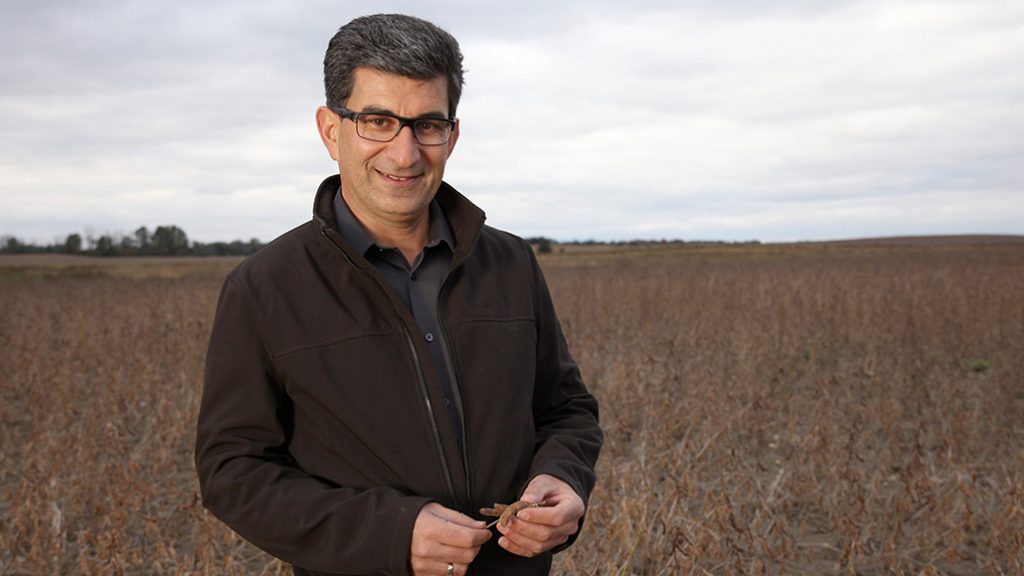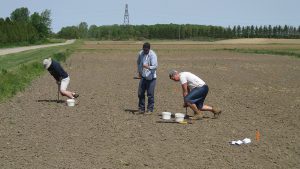Breeding a better soybean
PROMISING VARIETIES EMERGING

DEVELOPING SOYBEAN VARIETIES that perform better in terms of yield, protein content, and resistance to disease is a complicated, time-consuming, but ultimately rewarding job.
Just ask assistant professor Dr. Milad Eskandari, who works in the Department of Plant Agriculture at the University of Guelph Ridgetown Campus.
“I was fortunate when the opportunity arose to join the soybean breeding program just after I finished my PhD,” he says.
Eskandari is from Iran, where he obtained a bachelor’s degree in plant agronomy and plant breeding and a master’s in plant breeding. In 2006, when he decided to go for his PhD, he opted to move to Canada to study soybean genetics and breeding at the University of Guelph. He worked under Dr. Istvan Rajcan and by 2012, he had completed the doctorate. When a position opened up, he began working in the soybean breeding program in July 2013.
“Milad is very enthusiastic about and good at what he does,” says Willie Vanderpol, SeCan’s representative for market development in southwestern Ontario.
SeCan is a not-for-profit association that supplies certified seed through more than 600 independent member companies across the country. Vanderpol works with SeCan’s eastern Canadian research partners, including the University of Guelph, to ensure varieties are being developed to fit SeCan member and farmer customer needs.
With the untimely passing of previous soybean breeder Dr. Gary Ablett in 2010, the program was kept alive by the hard work and dedication of technicians Dennis Fisher and Bryan Stirling working under Rajcan’s direction.
“Having Milad bring his talents and enthusiasm to the program in recent years has ramped up progress and we are very excited to see the program returning to a high level of productivity,” says Jeff Reid, SeCan’s general manager. “This is a real success story in the making.”
END-USER PREFERENCES
Eskandari’s research focuses on food-grade soybeans that go into products such as miso, tofu, and soy sauce.
“One of the specific traits that we always try to improve is yield,” Eskandari says. A big sticking point, however, is that there’s a negative relationship between yield and protein — a much sought-after trait for the Asian customers who buy much of the crop.
Yield, protein content (ideally 41 to 42 per cent and higher), and seed size are the three highest priorities when Vanderpol and Eskandari decide which soybean lines to advance to commercialization. Resistance to soybean cyst nematode (SCN) is always included as a trait, given the fact that the disease is so widespread in southwestern Ontario. Having clear or yellow hilum colour is also a must for food-grade soybeans.
Eskandari says that new production issues are arising due to the fact that the vast majority of SCN resistance comes from one source — P188788. New, more virulent types of SCN are appearing in crops, so he’s working with different sources and is having some success with the cultivar Hartwig.
“If we could figure out the components of what makes yield tick, we could be smarter about increasing it,” he says.
“It’s difficult to find which genes control which traits and how they map together — Milad’s working on that and discovering which genes make better crosses,” Vanderpol says.
CONSISTENCY
Layered on top of the need for all these traits to work together is consistency over time and place.
“Products that have been around for 10, 15, 20 years and have consistent performance across a broad range of geographies are what producers are looking for,” Vanderpol says, adding that some varieties do very well in optimal growing seasons but fail to thrive in more challenging production years.
OAC Kent has been a popular variety for both producers and buyers for 17 years, and Eskandari is working to find a replacement that has improved agronomic and grain quality characteristics.
“We call it the workhorse soybean, it just keeps chugging along and is very consistent,” Vanderpol says, adding that OAC Kent usually doesn’t produce either the highest or the lowest yields in any given year.
Moving suppliers and buyers to try newer, better varieties is a difficult job, though. Producers want a seed that will have decent yields and command premium prices. Overseas customers want a reliable supply of soybeans that will always perform exactly the same way in the foods that they make.
Still, the quest for a better soybean continues, as does the research.
“There are plenty of lines in the pipeline that are being selected based on their performance,” Vanderpol says.
A promising new variety out of Eskandari’s program is called OAC Bruton, and it could be an OAC Kent replacement. Since its release to SeCan members in 2016, it has garnered increasing attention from the Ontario industry. It has demonstrated the trifecta of higher yields, increased protein content, and bigger seed size in trials and production so far.
“We’re ramping up seed production in 2019 and we believe it has a future, based on what we’ve seen so far,” Vanderpol says.
Time, testing, and end user acceptance will determine whether this variety will be produced in the long term. •




















